Two Feet in at the Natural Wine Incubator
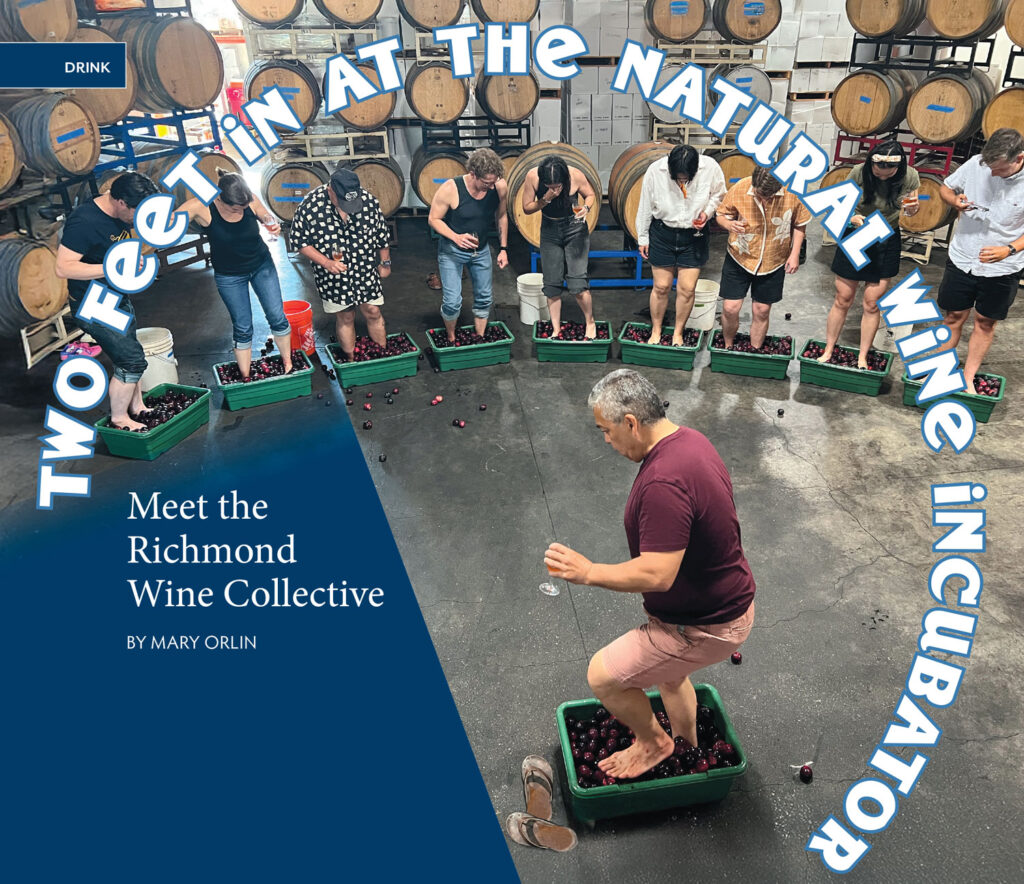
Purity Wine’s Noel Diaz leads a barefoot grape-stomping session at the Richmond Wine Collective. (photo: Barrie Quan)
A shared winery space on the west side of Richmond’s Marina Bay is abuzz with activity during the fall grape harvest. Grapes arrive and everyone takes off their shoes to stomp the fruit. As the juice ferments, winemakers punch the floating caps of grape seeds and skins back into the juice and later fill stainless-steel tanks and oak barrels with the newly made wines, which they will eventually blend, bottle, and label.
Here at the Richmond Wine Collective, an incubator for natural winemaking, members are exploring principles of minimal intervention in the age-old process of turning grapes into wines. They prioritize organically or biodynamically grown grapes and wild yeast fermentations, skip additives and filtering, and minimize the use of sulfur.
“The more natural wines that I tried, the more I liked their personalities,” says Noel Diaz. “They’re not homogeneous.”

Megan Sekermestrovich stomps valdiguié grapes (photo: David Keller). Right:Purity Wine’s Noel Diaz and Barrie Quan stomp some malvasia. (photo: Kathleen McKeeveny)
Diaz and his wife, Barrie Quan, became acquainted with natural wines through their restaurant hospitality careers. In 2013, they launched Purity Wine in a space on Treasure Island. Diaz made wine as Quan developed the business. They used grapes harvested from 120-year-old zinfandel vines at their own small vineyard in Sonoma County and bought grapes from other growers as well.
By 2017, Purity Wine had outgrown its Treasure Island space. Diaz and Quan found an ample warehouse in the Richmond Marina, where they set a vision for the Richmond Wine Collective (RWC), inviting in other natural winemakers—both budding and experienced—to work under the same roof. At RWC, members learn and experiment together as they share equipment and assist each other during harvest. “They have a dream, a passion project,” Diaz says. “They look to me for help.”
Since its opening, RWC has housed 29 wineries. Some move on, others stay put, but currently, 21 wineries operate in this collaborative space. For many members, wine is a side gig, and they produce only modest quantities per year.
Diaz and Quan also created the Study Wine Bar near RWC. Located along the Bay Trail bike path, it’s a place to taste and learn about RWC wines and purchase the bottles. In addition, they host a twice-yearly wine fair called By The Way, “a farmers’ market for wine,” as Diaz describes it, and another way to support local winemaking. “If we don’t support the local wineries, how are we ever going to have a wine culture?” he asks.
Here are four more current RWC winemakers who are building that culture.
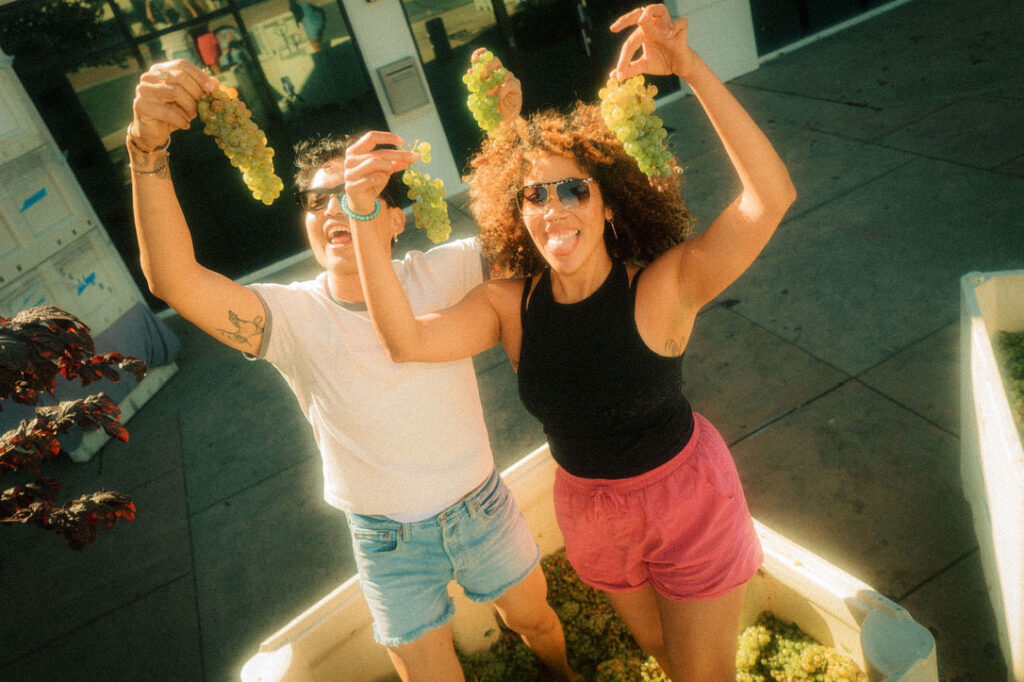
Laughing Gems’ Tiffani Patton and Jonathan Yang stomp orange muscat grapes. (photo: Jeremy Chiu)
Wine Pairs Best with Laughter
A fellow RWC winemaker once said to Laughing Gems cofounders Tiffani Patton and Jonathan Yang, “We always know when you guys are here because we can hear you laughing,” Patton says. Indeed, this duo does seem to see laughter as part of their winemaking process, and they also use sound healing during fermentation. “This conveys positive energy,” Patton says, “for the best outcome.”
Patton first met Diaz while doing food justice work at Paicines Ranch, a regenerative agriculture leader in San Benito County, and the ranch remains intrinsic to Laughing Gems wine as a source of their grapes. Patton says that she and Yang, an architect, bonded over hiking and their experiences being raised by Asian mothers. They found that the wines they wanted to drink with Asian food didn’t exist, so in 2023, they began creating their own wines at RWC. They make only 600 cases per year, but their Laughing Gems wines have become known for their light, petulant, and playful styles.
“Laughing Gems” denotes Patton and Yang’s sense of joy, their shared Gemini sun signs, and the image of the Laughing Buddha. Their logo, with its two laughing faces, is based on oracle bone script, the oldest written form of Chinese.
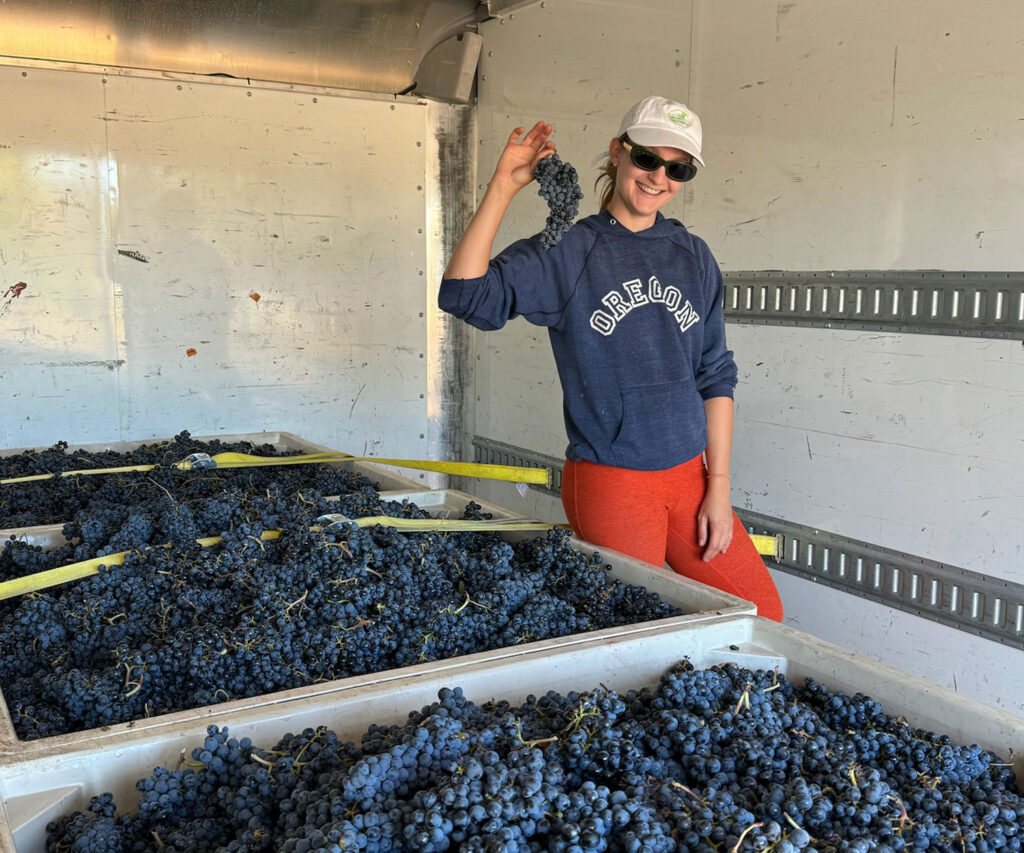
Lula winemaker Megan Sekermestrovich arrives at the Richmond Wine Collective with valdiguié grapes just harvested for her 2023 vintage State Flower wine. (photo: David Keller)
Fashionable Fermentations
Lula winemaker Megan Sekermestrovich makes just 60 cases per year and works only with sustainable growers who pay living wages.
“I am small but mighty,” says this Levi Strauss & Co fashion designer, who pursues winemaking as she does fashion: “They’re both creative avenues and very collaborative,” she says.
When a friend introduced her to natural wines, Sekermestrovich discovered they didn’t trigger her migraines. Curious, she went to work for a week at Maboroshi Vineyard, a biodynamic grower in Sonoma County. Then she visited RWC, where Noel Diaz invited her to make wine. She brought along her husband, David Keller, as her winemaking partner and photographer, and channeled a favorite fashion magazine, Lula Mag, for her brand’s name, Lula.
Being an outsider gives Sekermestrovich freedom to experiment. One of her biggest hits is a pink chardonnay. “I wanted to press the chardonnay fruit over red fruit because I knew it would be so pretty,” she says. For “This Wine Is Fire,” she used smoke-tainted grapes from the 2021 Sierra Foothills fires. Her State Flower labels honor all the states where she’s lived. “My labels are personal vignettes,” she says.
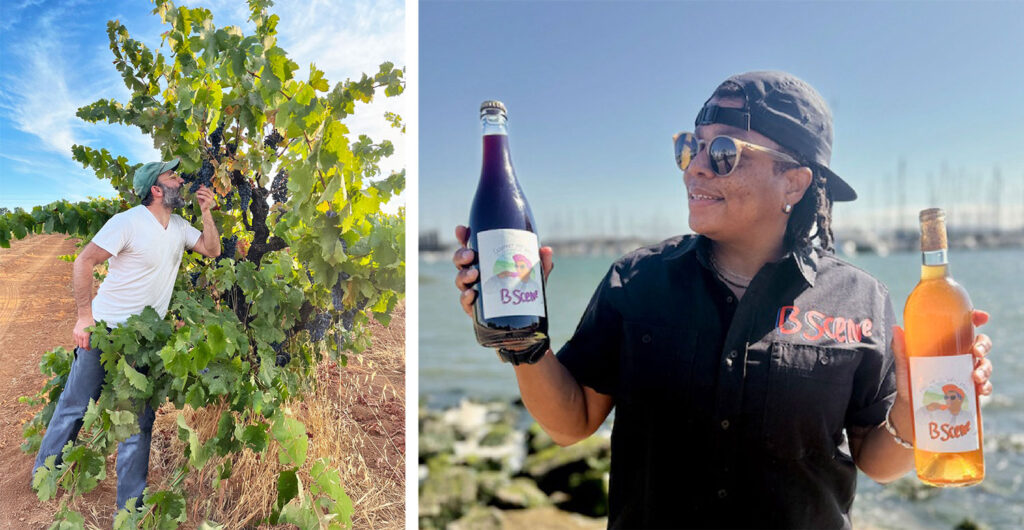
Hovik Winemaker John Semerdjian inspects old vine carignan vines in Redwood Valley, Mendocino County (courtesy: Hovik). BScene winemaker Bibi Adams on the Richmond waterfront with her Cabernet My Way and Mal–va–si–“ya”–Later! wines (courtesy: BScene).
A Love of Fermentation
Hovik Wines founder John Semerdjian was fermenting kimchi, kombucha, and sourdough when he learned about natural wine. It reminded him of sour beer. He guessed that winemaking would be financially out of reach, but on a visit to the Study Wine Bar, he began talking to Diaz, who encouraged him to start small. Since 2021, Semerdjian has been making 300 cases annually. He likes to press grapes over skins of a different variety that have been left in the press. “You extract some of that flavor and texture and acidity to add an extra layer of essence,” he says.
Semerdjian’s label design is a doodle on H O V I K, the Armenian equivalent of his first name, John, which he recreated as a linoleum block print. The name connects his winemaking to his parents’ native Armenia. “The wine tradition is in our culture, going back 6,100 years, with the world’s first-known winery,” he says.
Being Seen in Wine
While on her first wine tasting tour in Napa Valley, Bibi Adams found her questions going unanswered. “Most of the people pouring wine or in the tasting room were white males,” she says, “and my group of friends is definitely diverse.”
The experience lit up her thirst for learning, and wanting to make wine approachable for others, too, she created BScene, an informal place for people to come together and learn about wine.
While working at natural wine shop Oakland Yard, her palate shifted to fresher, brighter wines. At the Study, she met Diaz and the RWC winemakers. “I got sucked in,” she says. “Maybe I can do this.”
Adams launched BScene Wines in 2024 with a commitment to sourcing sustainably grown organic grapes. She made a skin-contact malvasia and a Napa Valley cabernet sauvignon piquette, a low-alcohol, fizzy wine made by a second pressing of the grape skins, seeds, and stems. “As a Black, queer woman having access to Napa grapes, I wanted to put my stamp on it,” she says.
Adams calls her winemaking a celebration of diversity. “It’s all about inclusivity, belonging. That’s why I came up with the name BScene,” she says. “I want to highlight women, people of color, and LGBTQ in the wine industry.” ´
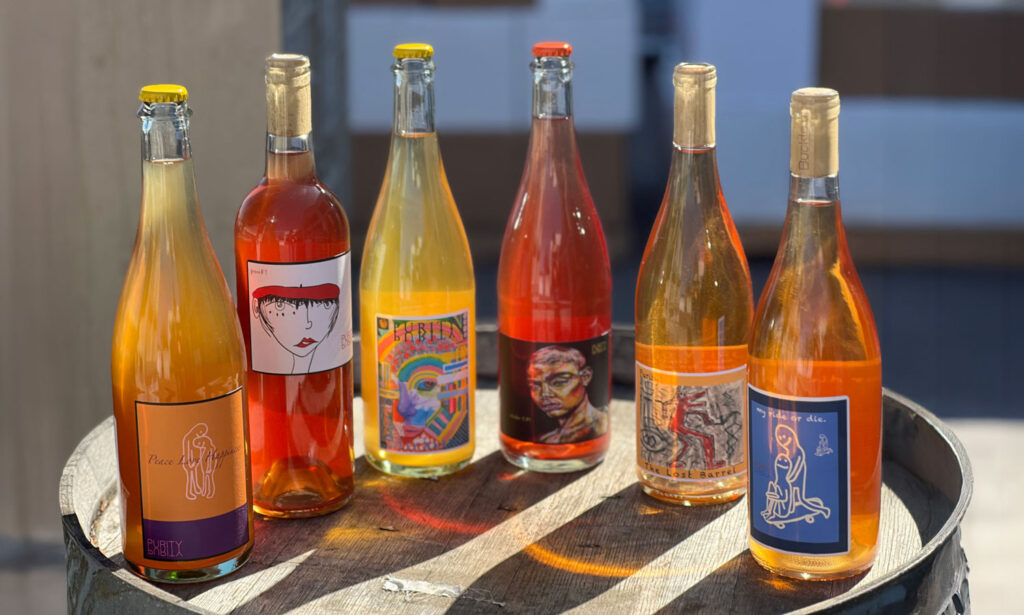
A selection of Purity Wines creations (photo: Barrie Quan).
Which wines should I try?
Here’s a sampling of colorful wines from these five Richmond Wine Collective members.
What to know: As is typical with “natty” or natural wines, most are cloudy and have no filtration. • Some bottles have crystals resting on the bottom. Called “wine gems,” these crystals are tartaric acid and are ok to ingest, but you might want to strain the wine. • Many of these wines are pét-nats (short for pétillant natural). They are slightly fizzy and are still fermenting in the bottle. • Some bring the funk. • All have lower alcohol levels, from 7% to 13.1%. • Availability of all wines is subject to change.
Purity Wine
puritywine.net/richmond-wine-collective
2023 Tutti Frutti Pét-Nat. This fizzy chardonnay zinfandel, cloudy carrot-orange in color, gives the sensation of biting into a juicy apricot.
2023 Highwire Malvasia. What do you get when you press white malvasia grapes over red cinsault grapes? A hazy, blood orange–colored wine that’s herbal and peachy with an amaro finish.
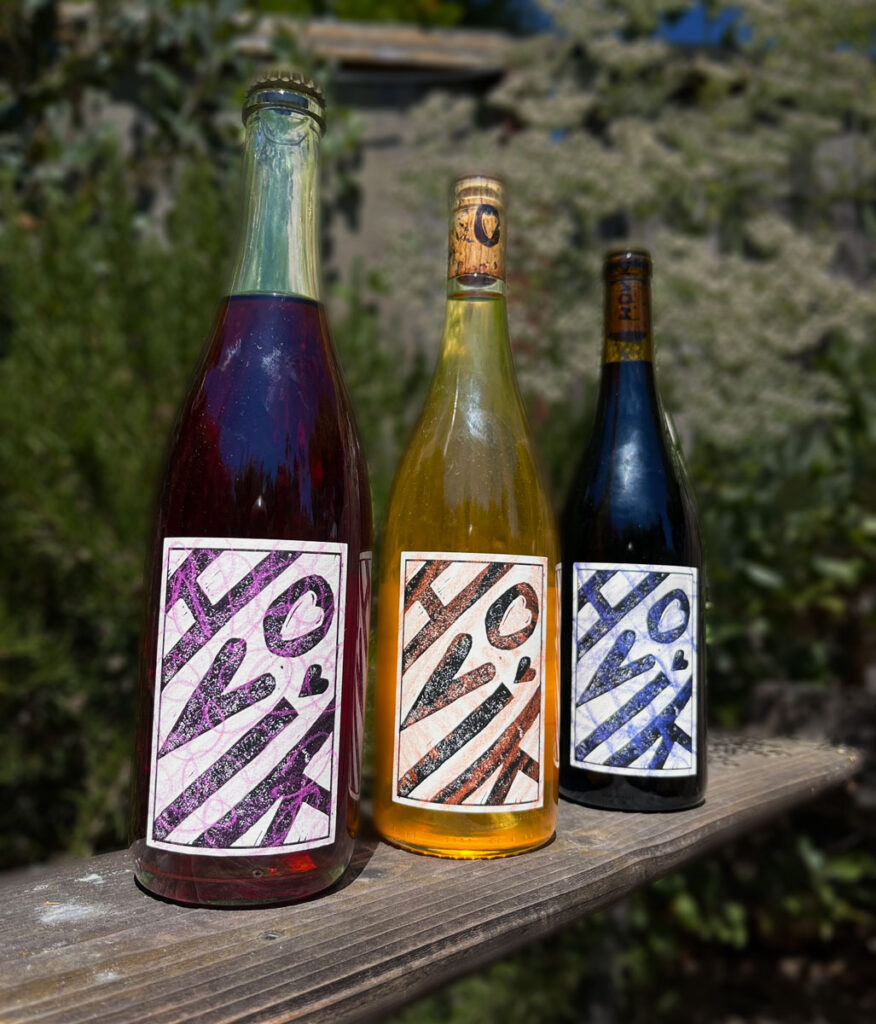
Hovik 2023 C’est Compliqué picpoul-carignan pet-nat; 2023 Love For Sale riesling; 2023 Cuvée Parsnip syrah-carignan (courtesy: Hovik)
Hovik Wines
2023 Love For Sale Riesling. After two weeks of skin contact, this peachy-hued, hazy, IPA-looking wine is bone dry and delightful, with white flowers, apricots, and peaches.
2022 Cabernet Franc Zinfandel. A bright ruby, easy drinking 50/50 blend with notes of violets, black fruits, pepper, and anise.
BScene
2024 Mal–va–si–“ya”–Later! The winemaker’s first wine, and you won’t want to say “see ya later.” Instead, this skin contact wine—malvasia pressed over muscat and gewurztraminer—is zesty, aromatic, and juicy, and keeps you coming back for more.
2024 Cabernet My Way Piquette. At 7% alcohol, it’s easy to go back for another glass of this quaffable wine, reminiscent of a berry ice pop. You’ve never had cabernet this way, but this piquette has personality and shows that Napa cabs don’t have to be big and bold to be delicious.
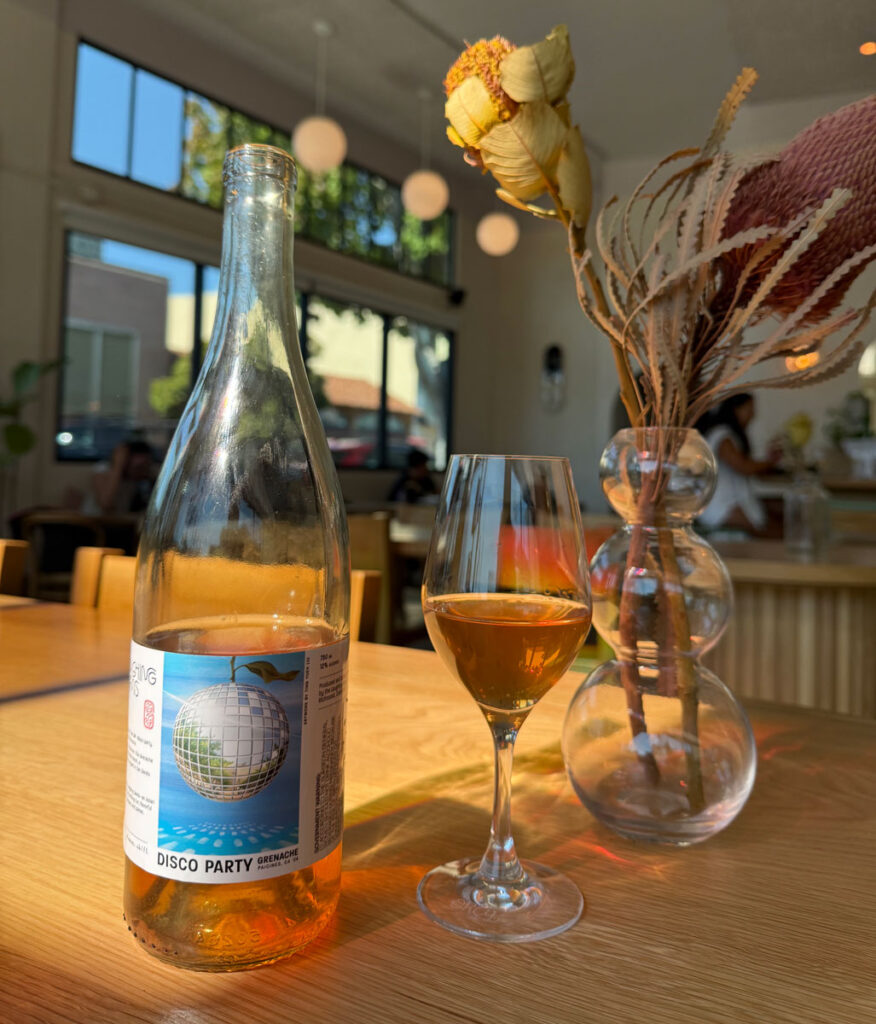
Laughing Gems Disco Party Grenache. The Paicines Ranch vineyard is reflected in the label’s disco ball. (photo: Jeremy Chiu)
Laughing Gems
2024 Disco Party Grenache. A party in your mouth. Hazy rose in color, it’s a lip smacking, fruity, herbal wine with zingy acidity.
2024 Super Fresh Orange Muscat Pét-Nat. Hazy lemon yellow, ebullient, and super fresh. There’s zippy acidity, vibrant white floral aromas, tropical fruit flavors, and a funkalicious finish.

Lula 2021 Pink Chardonnay and 2023 State Flower Valdiguié (courtesy: Lula)
Lula
2021 Pink Chard Pét-Nat. One of a kind. Pressing chardonnay grapes over red grapes imparts the pretty pink color. Frothy, with a hazy, rosy-amber glow, it’s luscious with tart, juicy blood orange and an Aperol-like finish.
2023 State Flower Valdiguié. A chillable red made by carbonic maceration, where fermentation takes place inside each grape and imparts a bubble gum quality, State Flower is fresh and fruity, full of red berries, lavender, and savory herbs.
Mary Orlin is a James Beard Award– and Emmy Award–winning writer and TV producer and a WSET Advanced certified sommelier. For many years she was the Mercury News wine writer and was executive producer of NBC’s national wine show, In Wine Country. She now co-hosts a tasty podcast called Sip Sip Hooray, exploring winemakers, wine, and other spirited libations.

